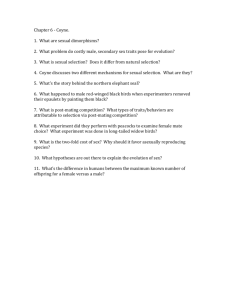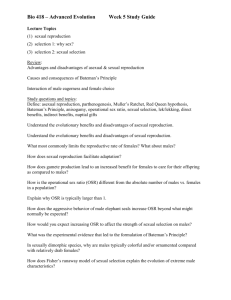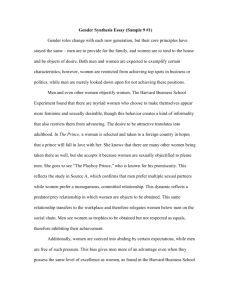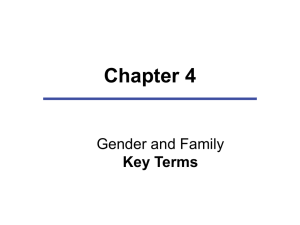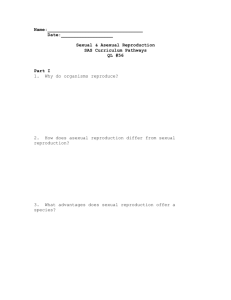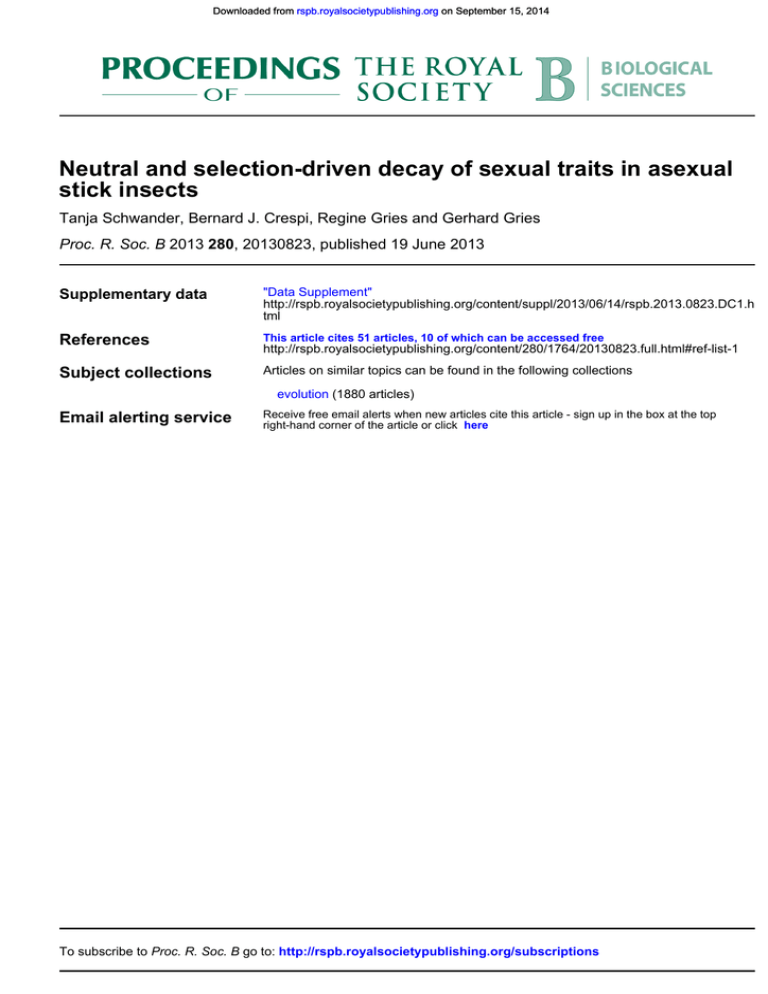
Downloaded from rspb.royalsocietypublishing.org on September 15, 2014
Neutral and selection-driven decay of sexual traits in asexual
stick insects
Tanja Schwander, Bernard J. Crespi, Regine Gries and Gerhard Gries
Proc. R. Soc. B 2013 280, 20130823, published 19 June 2013
Supplementary data
"Data Supplement"
http://rspb.royalsocietypublishing.org/content/suppl/2013/06/14/rspb.2013.0823.DC1.h
tml
References
This article cites 51 articles, 10 of which can be accessed free
Subject collections
Articles on similar topics can be found in the following collections
http://rspb.royalsocietypublishing.org/content/280/1764/20130823.full.html#ref-list-1
evolution (1880 articles)
Email alerting service
Receive free email alerts when new articles cite this article - sign up in the box at the top
right-hand corner of the article or click here
To subscribe to Proc. R. Soc. B go to: http://rspb.royalsocietypublishing.org/subscriptions
Downloaded from rspb.royalsocietypublishing.org on September 15, 2014
Neutral and selection-driven decay of
sexual traits in asexual stick insects
Tanja Schwander1,†, Bernard J. Crespi2, Regine Gries2 and Gerhard Gries2
rspb.royalsocietypublishing.org
Research
Cite this article: Schwander T, Crespi BJ,
Gries R, Gries G. 2013 Neutral and selectiondriven decay of sexual traits in asexual stick
insects. Proc R Soc B 280: 20130823.
http://dx.doi.org/10.1098/rspb.2013.0823
Received: 3 April 2013
Accepted: 28 May 2013
Subject Areas:
evolution
Keywords:
regressive evolution, trait decay,
relaxed selection, asexuality
Author for correspondence:
Tanja Schwander
e-mail: tanja.schwander@unil.ch
†
Present address: Department for Ecology and
Evolution, University of Lausanne, Biophore,
1015 Lausanne, Switzerland.
Electronic supplementary material is available
at http://dx.doi.org/10.1098/rspb.2013.0823 or
via http://rspb.royalsocietypublishing.org.
1
Center for Ecological and Evolutionary Studies, University of Groningen, Nijenborgh 7, 9700 CC Groningen,
The Netherlands
2
Department of Biological Sciences, Simon Fraser University, Burnaby, British Columbia, Canada V5A 1S6
Environmental shifts and lifestyle changes may result in formerly adaptive
traits becoming non-functional or maladaptive. The subsequent decay of
such traits highlights the importance of natural selection for adaptations,
yet its causes have rarely been investigated. To study the fate of formerly
adaptive traits after lifestyle changes, we evaluated sexual traits in five independently derived asexual lineages, including traits that are specific to males
and therefore not exposed to selection. At least four of the asexual lineages
retained the capacity to produce males that display normal courtship behaviours and are able to fertilize eggs of females from related sexual species.
The maintenance of male traits may stem from pleiotropy, or from these
traits only regressing via drift, which may require millions of years to generate phenotypic effects. By contrast, we found parallel decay of sexual
traits in females. Asexual females produced altered airborne and contact
signals, had modified sperm storage organs, and lost the ability to fertilize
their eggs, impeding reversals to sexual reproduction. Female sexual traits
were decayed even in recently derived asexuals, suggesting that trait
changes following the evolution of asexuality, when they occur, proceed
rapidly and are driven by selective processes rather than drift.
1. Introduction
Studies on how natural selection favours adaptations typically focus on the
evolution of novel traits [1–4]. However, the fate of traits that no longer contribute to fitness can also highlight the importance of natural selection for adaptive
traits [5–8]. Formerly adaptive traits may become non-functional, or even maladaptive, as a consequence of environmental shifts or changes in lifestyle,
accompanied by changes in selective pressures [5,8]. Such traits often decay
and in some cases may disappear completely.
Trait decay represents a form of regressive evolution, which Haldane
suggested may be more than tenfold more common than adaptive evolution
towards more complex phenotypes [4]. It can occur via different mechanisms,
depending on whether the formerly adaptive trait is neutral or maladaptive
in the new selective environment. In the first case, the trait would be under
relaxed selection, whereby trait-affecting mutations that would have been
removed by selection under the past conditions may accumulate and fix via
drift [9,10]. This process of neutral mutation accumulation would be expected
to proceed slowly (reviewed in [11]). In the second case, the trait would be
expected to regress rapidly, driven by selection for reduced or modified trait
expression [5,12,13]. However, trait decay is not necessarily accompanied by
a degeneration of the associated molecular pathways. Maintenance of pathways
may stem, for example, from pleiotropy, where the same gene networks function in several processes [5]. Thus, even if a character is phenotypically
absent, the genetic information responsible for its development can remain
quiescent, occasionally resulting in character expression.
An exceptionally large range of traits is expected to decay in asexually reproducing organisms. All higher asexual eukaryotes derive from sexual ancestors
[14], and many ‘sexual traits’ (that is, traits involved in mate location and attraction, mating, or traits specific to the male sex) should become useless or
& 2013 The Author(s) Published by the Royal Society. All rights reserved.
Downloaded from rspb.royalsocietypublishing.org on September 15, 2014
Five different asexual Timema species have been described based
on morphological and host plant information [26–28], and previous studies revealed that these species correspond to at least
seven independent transitions to asexuality, ranging in age from
recent to old (table 1). We investigated sexual traits in five of
the seven asexual lineages (ranked by increasing age: T. shepardi,
T. douglasi ‘south’, T. genevievae, T. tahoe and T. monikensis), as
well as in their closest sexual sister species (table 1).
During our field collections in spring 2007– 2012, we found
11 asexually produced males (see §3). For seven of these 11
males, we were able to evaluate courtship behaviour and fertilization success by pairing these males with virgin females of their
respective sexual sister species. Although asexually produced
males do not currently encounter sexual females in natural populations because of their non-overlapping distribution ranges, we
used sexual females for these pairings because they were more
likely to elicit sexual behaviour in males than the asexual
females, and because we were unable to obtain copulations of
asexually produced males with females of their own species,
despite repeated efforts.
Male courtship behaviour varies little among sexual Timema
species. It is initiated by the male after climbing onto the female’s
dorsal surface, and involves ‘leg waving’ (rapidly kicking
asexual species
age range
(1000 yr)
sexual sister
species
T. shepardi
T. douglasi (‘central’)
100 – 400
100– 450
T. californicum
T. poppensis
T. douglasi (‘south’)
T. douglasi (‘north’)
700 – 600
1000 –950
T. poppensis
T. poppensis
T. genevievae
1500 – 1450
T. podura
T. tahoe
T. monikensis
450 – 1550
100 – 1850
T. bartmani
T. cristinae
posterior legs to the side, whereby different species kick with
either two or four posterior legs), followed by ‘antennae waving’
and copulation attempts [29]. We evaluated whether the asexually
produced males used this same courtship sequence, and whether
they waved the same posterior legs as their sexual sister species.
Sperm functionality in the seven asexually produced males
was evaluated in crosses with virgin females of the sexual species
(two per male). In addition, to test whether asexually produced
males were able to also fertilize eggs when in (sperm) competition with other males, each of them was mated to two
additional females, either 24 h before or after these females
mated with a conspecific male. The 28 mated females were
then maintained individually in plastic cups with cuttings of
their host plant and allowed to lay about 40 eggs each (which
takes 25 – 40 days). Offspring hatching from these eggs, as well
as their ( putative) parents, were genotyped at the four microsatellites Tim1, Tim4, Tim6 and Tim7 [30] to assess paternity.
The three of the 28 females that died before they laid enough
eggs (one singly and two doubly mated females) were replaced
by new females mated to the dead females’ mating partner(s).
To evaluate the fate of female-specific sexual traits in asexuals, we considered pheromone production and attractiveness
to males, as well as the fate of the spermatheca (a pocket
where sperm is stored [31]) and egg fertilization. Previous behavioural experiments provided evidence for airborne and contact
pheromonal cues produced by females in the sexual species
[29,32]. We therefore evaluated the attractiveness of asexual
females to males of their sexual sister species at longer distances
as well as upon contact.
To test whether asexual females emit pheromonal signals
attractive to males, we conducted two-choice trials in horizontal
Y-mazes (stem and side arms: 10 cm long 3.5 cm diameter
each; angle between side arms: 1208). By random assignment,
the orifice of a side arm received a food leaf with or without a
female within a mesh-covered glass tube. Females were left in
the maze for at least 15 min before a male was introduced. Fifteen
minutes after introducing a male, we recorded whether he had
walked two-thirds of the length of the female-containing side
arm. Males of the five sexual species were tested against females
of three groups: (i) asexual females (of the sister-lineage to the
male’s species; table 1), (ii) sexual females of the males’ own
species and (iii) sexual females of a different species. The
sexual females of a different species were used as controls;
some degree of reduced attractiveness of asexual females to
males of their closest sexual sister species may be expected
because of between-species differences rather than because of
asexuality. For each of the five sexual species, we conducted
109 – 211 trials (30– 98 for each of the three female groups), for
a total of 751 two-choice trials, with different individuals used
2
Proc R Soc B 280: 20130823
2. Material and methods
Table 1. Independently derived asexual Timema lineages and their sexual
sister species, ranked by increasing upper age estimates (age estimates
from [25], based on intra- and interspecific molecular divergences). The
asexual lineages in bold were included in this study.
rspb.royalsocietypublishing.org
maladaptive after the transition to asexuality, as demonstrated
in previous studies [15–18].
Distinguishing selection from drift is a major challenge in
studies of trait decay following a change in the selective
environment [5,16], but the fate of sexual traits in asexuals
can provide insights into both of these processes. The majority
of asexual lineages produce either no males, or may produce
occasional males that do not have mating opportunities or
success in natural populations [19–21]. Male-specific traits
are therefore not exposed to selection in asexuals, such that
male trait decay would either stem from neutral mutation
accumulation [22] or pleiotropic effects expressed in females.
In contrast to the male-specific traits, certain sexual traits
expressed in females (for example, those involved in mate
attraction) are unlikely to be neutral in asexuals. In addition
to possible energy costs associated with the production of
mate attraction signals, pheromones or acoustic signals are
prime targets for predators and parasitoids to locate their
prey [13,23]. Thus, the production of such signals should be
under strong negative selection in asexuals, where mate
attraction is superfluous.
Few previous studies have analysed the causes and rates
of trait decay, especially in phylogenetic contexts that allow
for replicated inferences concerning patterns of evolutionary
change. Here, we investigate the fate of a suite of sexual
traits, including male-specific traits, in five independently
derived asexual stick insects in the genus Timema. Because
the transitions from sexual reproduction to asexuality have
occurred at different times in these lineages (some lineages
are recently derived asexuals while others have been asexual
for over one million years [24,25]), a temporal component can
be included, with a higher level of sexual trait decay expected
in old when compared with young asexual lineages. Our
results show that neutral traits display little or no regression
even in old asexuals, whereas ( presumably) selected traits
display major shifts already in young asexuals, such that
reversals to sexual reproduction are unlikely, even for
recently derived asexual lineages.
Downloaded from rspb.royalsocietypublishing.org on September 15, 2014
1.0
3
0.8
T. californicum males
0.6
0.4
0.2
cali shep knu
pet popp cris pod boh chum bart
1.0
0.8
T. poppensis males
0.6
0.4
0.2
0
popp dou knu
pet cali cris pod boh chum bart
1.0
0.8
T. podura males
0.6
0.4
0.2
0
pod gen boh bart chum popp cris knu cali pet
1.0
0.8
T. bartmani males
0.6
0.4
0.2
0
bart tah
pod boh chum cris popp pet
knu cali
1.0
0.8
T. cristinae males
0.6
0.4
0.2
0
cris mon popp knu pet cali chum bart pod boh
female species
high
low
genetic divergence to male species
Figure 1. Females of asexual species are characterized by reduced sexual
attractiveness to males of closely related sexual species, whereby this
reduction is not solely explained by genetic divergence between species. Indicated is the proportion of copulations of sexual males with females of their
own species (light grey bars), their asexual sister species (dark grey bars) and
related sexual species (white bars). Female species are ordered according to
increasing nuclear genetic divergence from focal males, with intraspecific
matings first and matings with females from the most distantly related
species last. bart, T. bartmani; boh, T. boharti; cali, T. californicum; chum,
T. chumash; cris, T. cristinae; gen, T. genevievae; knu, T. knulli; pet,
T. petita; pod, T. podura; popp, T. poppensis; shep, T. shepardi; tah, T. tahoe.
3. Results
Males are produced at a very low rate by the asexual lineages.
Out of over 5000 individuals collected in the field, only 11
were males: three T. shepardi, two T. douglasi ‘south’, five
T. monikensis and one T. genevievae. No male has thus far
been found for T. tahoe. We found no evidence for decay of
courtship behaviour when pairing asexually produced
males with females of their sexual sister species, although
their small numbers precluded a quantitative assessment.
Proc R Soc B 280: 20130823
proportion of copulations of males with females from related and diverged species
0
rspb.royalsocietypublishing.org
in every trial. The proportion of trials in which males chose the
female-containing tube, out of the total number of trials conducted for a given female group, was considered proportional
to the ‘attractiveness’ of putative airborne pheromonal cues
emitted by females.
Contact attractiveness of asexual females was tested in nochoice trials, which were conducted by introducing one male and
one female into a 6 cm Petri dish and recording after 1 h whether
the pair was in copula [29,33]. In each replicate, we paired a
male of the five focal sexual species with a female of their asexual
sister species, or with a female of their own species (with 20–106
trials per species combination). Similar to the Y-maze tests, we
also used females of other sexual species as a control for reduced
attractiveness because of species divergences. However, we used
females from eight different sexual species instead of only one,
ranging from closely to distantly related to the species of the
focal males (figure 1). Mating propensity for each male species
by female species combination was then estimated as the proportion of copulating pairs out of the total number of trials
conducted for that combination (see the electronic supplementary
material, table S1 for sample sizes per species combination).
Because a previous study [29] suggested that cuticular hydrocarbons of females may provide signals for mate discrimination
in sexual Timema species, we quantified the relative amounts of
six hydrocarbon components (3-, 5-, 7-, 9-, 11- and 13-methylheptacosane) on the cuticule of five to 10 virgin adult females (for
methods see the electronic supplementary material). To quantify
the extent of the profile shift between each asexual lineage and its
sexual sister species, we calculated the average of multivariate
Euclidian distances (where each hydrocarbon component defines
an axis in a multi-dimensional space) between all sexual and
asexual individuals of a species pair. We then compared this distance with the profile differences (also measured by Euclidian
distance averages) between sexual species pairs. The removal
of selection on females to produce male-destined cues may also
result in asexual females producing less precise (i.e. more variable) cues. We therefore determined for each species the
hydrocarbon profile variability, by calculating the average profile
distance between two individuals, and compared this distance
between reproductive modes.
We also tested whether eggs produced by asexual females
could still be fertilized, and whether egg hatching success for
asexual females was affected by copulations with males (as
there could be interference between sperm and asexual embryo
development). We aimed at obtaining 10 mated females per
asexual species. Because very few asexual females mated
during the standardized no-choice mating trials (see §3), we
paired numerous asexual females with males of their sexual
sister species for up to 8 h and checked regularly for copulations.
The mated asexual females were maintained individually in plastic cups with cuttings of their host plant and allowed to lay eggs
for approximately three weeks. The females were dissected to
verify that their spermatheca contained sperm, and each
female, her mating partner and four to eight of her offspring
were microsatellite-genotyped to determine whether the males’
sperm was included in the offspring’s genome. For each asexual
species, the egg hatching success of the 10 mated females was
compared with the hatching success of 20 unmated females
that, except for the mating trials, had been treated and maintained
in the same way as the mated females.
Finally, we compared the spermathecae of the sexual and
asexual Timema to test for decay of a morphological trait.
Timema females have spermatheca comprising two separate
pockets (figure 2) [31]. We measured the maximum length and
height of both pockets of 10– 13 virgin females per species on pictures taken with a Motic Images 2000USB camera on a Zeiss
Stemi SV 6 stereo microscope (at 50 magnification) using
MOTIC IMAGES PLUS v. 2.0 (Motic Group Co., Ltd.).
Downloaded from rspb.royalsocietypublishing.org on September 15, 2014
(a)
(b)
within-species hydrocarbon
profile variation
0.16
0.12
0.08
0.04
0
T. shepardi–
T. douglasi– T. genevievae– T. tahoe–
T. monikensis–
T. californicum T. poppensis T. poppensis
T. bartmani T. cristinae
species pair
Figure 3. Within-species hydrocarbon profile variation (measured as the average profile distance between two individuals) for asexual Timema lineages
(grey bars) and their sexual sister species (white bars).
relatively small (MANOVA; Wilks’s l ¼ 0.2, F1,18 ¼ 6.7,
p , 0.001), while profile divergences were considerable for
all other sexual–asexual species pairs (MANOVA; Wilks’s l:
0.001–0.1, all p , 0.0001). Within each of the sexual–asexual
species pairs, the profiles were more variable among asexual
than sexual females (paired t-test: t4 ¼ 4.3, p ¼ 0.01; figure 3).
As in a previous study of spermathecae in sexual and
asexual wasps [34], spermathecal morphology clearly differed
between the sexual and asexual Timema. The two spermathecae pockets of virgin sexual females were spherical, whereas
they were flattened in asexual females (reflected by significantly different length/width ratios between sexual and
asexual females within each species pair; F1,100 ¼ 9.5, p ¼
0.003). Within each sexual–asexual species pair, the two spermatheca pockets were more asymmetric for asexual females
(F1,100 ¼ 5.3, p ¼ 0.02), possibly reflecting decreased developmental stability in asexuals. Even though males generally
transferred sperm when copulating with asexual females (we
found spermatozoa in the spermatheca of 44 of the 50 mated
asexual females), we found no evidence for fertilization of
asexually produced eggs. Out of 322 offspring genotyped,
none had any genetic contribution from the males. The
hatching rate of eggs laid by asexual females was also not
affected by whether the females had copulated with a male
(F1,98 ¼ 0.48; p ¼ 0.42).
4. Discussion
We investigated the fate of sexual traits in five independently
derived asexual stick insect lineages, including old and
Proc R Soc B 280: 20130823
Figure 2. Spermatheca of (a) a sexual female (T. californicum) and (b) an
asexual female (T. shepardi) at 50 magnification. (Online version in colour.)
4
rspb.royalsocietypublishing.org
The courtship sequences performed by these males were
identical to those described for sexual males. Furthermore,
T. shepardi and T. douglasi ‘south’ males used two posterior
legs for leg waving, similar to their sexual sister species
T. californicum and T. poppensis, whereas T. monikensis and
T. genevievae males used four legs, matching the pattern
described for T. cristinae and T. podura.
Each asexually produced male fathered offspring when
mated to virgin females of his sexual sister species, indicating
that these males still produce functional sperm. The hatching
success among eggs from these crosses was low (mean + s.d.:
29.5 + 15.2%), but it is not possible to assess whether low
hatching success is a consequence of poor sperm quality or
hybrid breakdown, given that at least the older sexual –
asexual species pairs have diverged for over a million years
(table 1). Asexually produced males fathered no offspring,
however, when these males copulated with a sexual female
that also mated with a male of her own species. Microsatellite
genotyping revealed that not a single offspring produced by
these doubly mated females was fathered by a male of the
asexual lineages, independently of whether this male was
the female’s first or second mating partner. The hatching
rate among eggs produced by these doubly mated females
(mean + s.d.: 42.1 + 16.7%) was also significantly higher
than the hatching rate of eggs from females mated only to
an asexually produced male (F1,26 ¼ 4.3, p ¼ 0.047).
In contrast to the maintained male traits, we found evidence for decay for each of the investigated female sexual
traits. Females of all five asexual lineages were significantly
less attractive to males than sexual females at both long
range (mediated by a volatile signal) and upon contact. In a
Y-maze, males approached the asexual females significantly
less often than the sexual females of their own species (Fisher’s
exact tests, all p , 0.05). This loss of attractiveness was not
solely due to genetic divergence between sexual and asexual
species, as asexual females were as unattractive to males as
females of diverged sexual species for four of the five asexual
lineages tested (T. douglasi ‘south’, T. genevievae, T. tahoe and T.
monikensis; Fisher’s exact tests, all p . 0.4). Only females of the
youngest asexual, T. shepardi, were more attractive to males of
their sexual sister species than females of a diverged sexual
species (Fisher’s exact test: p ¼ 0.041).
Reduced attractiveness of asexual females to sexual males
was even more pronounced in no-choice mating trials. Males
of four of the five sexual species courted and copulated significantly less often with females of their asexual sister species
than with sexual females, irrespective of the genetic divergence
between the male and the sexual female (all p , 0.01; figure 1).
For the fifth sexual species, T. bartmani, the proportion of copulations with females of the asexual T. tahoe was comparable
with the proportion of copulations with females of the closest
sexual species, T. podura (figure 1). Furthermore, asexual
females actively resisted many copulation attempts from
males by moving their abdomen away (T.S. 2007–2012, personal observation) while this behaviour is only rarely
observed among sexual females [29] (T.S. 2007–2012,
personal observation).
Consistent with the decayed attractiveness of asexual
females, asexual females displayed hydrocarbon profiles
more variable than and distinct from those of females of
their sexual sister species. The hydrocarbon profile divergences between females of the young asexual T. shepardi
and its sexual sister T. californicum were significant but
Downloaded from rspb.royalsocietypublishing.org on September 15, 2014
5
Proc R Soc B 280: 20130823
generate functional males. Second, significant levels of trait
decay may typically occur via selective processes rather than
by drift; it may well be that neutral decay would require hundreds of millions of years, a time frame rarely reached by
asexual lineages [53]. Finally, the development of functional
males may indicate that lineages presumed to be asexual
have some low level of cryptic sex. However, although formally demonstrating the lack of sexual reproduction in a
lineage is challenging [53], this explanation is unlikely in
groups that display the genomic signatures of asexuality,
such as Timema [25,30,54], and is difficult to reconcile with
decay of sexual traits in females, reported in cases with functional males [37] (this study).
Indeed, all female sexual traits investigated in Timema
displayed significant shifts in asexual females relative to
the sexual sister species. Spermatheca morphology and the
ability to fertilize eggs seem to have decayed since the
abandonment of the formerly sexual lifestyle. The decay of
long- and short-distance mate attraction in asexuals, in
addition to potential mate recognition cues being more variable in asexual when compared with sexual females, is also
consistent with decayed sexual signal production. However,
if copulating with males incurs costs to asexual females,
then traits that decrease the probability of matings may be
selectively favoured, and decreased mating probability may
stem from signals with novel compositions, rather than
from reduced signal expression.
Although more extensive sexual decay may be predicted
for old when compared with young asexuals, we found
little effect of the age of Timema asexuals on sexual trait
expression. For male traits, considered to be neutral, we
found no regression in any of the asexuals, whereas for
female traits, the effect sizes of the trait shifts were mostly
unrelated to how long a given lineage has been asexual.
The sole exception is attractiveness to sexual males, where
only females of the youngest asexual, T. shepardi, appeared
to be somewhat attractive to males of their sexual sister
(T. californicum). This lack of strong differences between
young and old asexuals may indicate that decay of female
sexual traits is generally selectively favoured, such that it
would spread rapidly enough to occur even in recently
derived asexuals (younger than 100 000 years). Consistent
with this view, studies of other asexual lineages, most of
them representing very recently derived asexuals, have
reported reduced mate attraction and mating propensity of
asexual when compared with sexual females. Thus, females
of Drosophila mercatorum parthenogenetic strains showed
reduced mating propensity compared with females of sexual
strains [15]. In bushcrickets, where males of sexual species
attract females with songs, the asexual species Poecilimon
intermedius has lost phonotaxis [18,55]. Female mating behaviour is also strongly reduced or lost in many species with
endosymbiont-induced parthenogenesis [41,42,47] (but see
[43]). Although Potamopyrgus snails, where females appear to
play a passive role in mate finding and copulation, may represent an exception to this pattern [56], these parallel and
rapid losses of different female traits involved in mate attraction and mating suggest that selective mechanisms, rather
than drift, are driving trait changes.
In conclusion, we find parallel decay of female sexual traits
and the maintenance of male traits across independently
derived asexual Timema lineages. The lack of decay for male
traits may stem from pleiotropy, or from these traits only
rspb.royalsocietypublishing.org
recently derived ones. At least four of five lineages are still
able to produce functional males, although these males,
given the lack of partners for reproduction, appear to have
zero fitness in natural populations. Sexual Timema species
are characterized by an XX : XO sex determination system
(males are the heterogametic sex, carrying only a single X
chromosome [30]). Most likely, male development in the
Timema asexuals follows an accidental loss of an X chromosome during oogenesis, whereby the existence of such
asexually produced males indicates that the molecular
pathways underlying male development remain functional.
The maintenance of male developmental pathways under
asexuality seems to be widespread, as occasional production
of males has been reported in a range of asexual lineages (e.g.
Potamopyrgus antipodarum snails [35], Saga pedo crickets [36],
thrips [21] and most asexual hymenopterans [37]). Notably,
males are not only produced in recently derived asexual
linages but have even been found in darwinulid ostracods
[38] and oribatid mites [20], groups that may have been
asexual for over 100 million years [39,40]. Tests for trait
decay in asexually produced males have been conducted in
hymenopterans with endosymbiont-induced parthenogenesis [37,41,42], where males are produced by asexual
females cured of their endosymbionts [43]. With few exceptions [44], these males appear fully functional, produce
viable sperm [37,41,45,46] and sometimes even father similar
numbers of offspring as sexual males [47,48] when mated
to females from related sexual strains or species. Only in
exceptional instances, notably in ‘ancient’ asexuals, has
male functionality appeared to have decayed, as suggested
by the lack of sperm in the darwinulid males [49] and the
production of non-functional spermatophores by males in
the oribatid mites [20].
In Timema, we found that asexually produced males only
successfully fathered offspring when the sole mating partner
of sexual females. They fathered no offspring in situations of
sperm competition with sexual males. Whether this effect is
due to sperm from asexual males performing poorly in situations of sperm competition or to cryptic female choice
remains to be investigated. Independently of the mechanism,
this result is unlikely to stem from sexual trait decay in these
males. Rather, it could indicate the improved competitiveness
of the sexual males’ sperm, driven by ongoing intra-sexual
conflict, relative to sperm properties present several thousand
generations earlier and ‘frozen’ as such in the asexuals’
genomes.
Males in a minority of asexual lineages (notably asexuals
recently derived from cyclical parthenogenetic ancestors such
as Daphnia waterfleas and aphids) successfully mate with
females of related sexual lines and thereby generate new
asexual lineages (‘contagious parthenogenesis’ [50,51]).
Contagious parthenogenesis can account for the maintenance
of male developmental pathways in asexuals, given the
mating success of asexually produced males. However, there
is currently little evidence that contagious parthenogenesis
occurs in natural populations of species outside the cyclical
parthenogens [50,52]. In the absence of mating success for
males produced by asexual females, the maintenance of male
functionality could stem from three non-exclusive mechanisms. First, male developmental and physiological pathways
may consist almost exclusively of components with pleiotropic
effects on both sexes. When, by some rare accident, the male
developmental pathway is triggered, it would therefore still
Downloaded from rspb.royalsocietypublishing.org on September 15, 2014
asexuality, if they occur, proceed rapidly and are probably
more driven by selective processes than by drift.
Data accessibility. Data archived in the Dryad repository under doi:10.
5061/dryad.sj6p8.
References
1.
3.
4.
5.
6.
7.
8.
9.
10.
11.
12.
13.
14.
15.
16. Dorken ME, Neville KJ, Eckert CG. 2004 Evolutionary
vestigialization of sex in a clonal plant: selection
versus neutral mutation in geographically peripheral
populations. Proc. R. Soc. Lond. B 271, 2375–2380.
(doi:10.1098/rspb.2004.2875)
17. Pannebakker BA, Beukeboom LW, van Alphen JJ,
Brakefield PM, Zwaan BJ. 2004 The genetic basis of
male fertility in relation to haplodiploid
reproduction in Leptopilina clavipes (Hymenoptera:
Figitidae). Genetics 168, 341–349. (doi:10.1534/
genetics.104.027680)
18. Lehmann GUC, Siozios S, Bourtzis K, Reinhold K,
Lehmann AW. 2011 Thelytokous parthenogenesis and
the heterogeneous decay of mating behaviours in a
bushcricket (Orthopterida). J. Zool. Syst. Evol. Res. 49,
102–109. (doi:10.1111/j.1439-0469.2010.00588.x)
19. Scali V. 1968 Biologia riproduttiva del Bacillus
rossius (Rossi) nei dintorni di Pisa con particolare
riferimento all’influenza del fotoperiodo. Atti Soc.
Tosc. Sc. Nat. 75, 108 –139.
20. Taberly G. 1988 Recherches sur la parthénogenèse
thélytoque de deux espèces d’acariens oribates:
Trhypochthonius tectorum (Berlese) et Platynothrus
peltifer (Koch). IV. Observations sur les mâles
ataviques. Acarologia 29, 95 –107.
21. Mirab-Balou M, Chen X-X. 2010 First description of the
male of the wheat thrips, Anaphothrips obscurus
(Thysanoptera: Thripidae). Zootaxa 2540, 65–68.
22. Masel J, King OD, Maughan H. 2007 The loss of
adaptive plasticity during long periods of
environmental stasis. Am. Nat. 169, 38 –46.
(doi:10.1086/510212)
23. Zuk M, Kolluru GR. 1998 Exploitation of sexual
signals by predators and parasitoids. Q. Rev. Biol.
73, 415– 438. (doi:dx.doi.org/doi:10.1086/420412)
24. Law JH, Crespi BJ. 2002 The evolution of geographic
parthenogenesis in Timema walking-sticks. Mol.
Ecol. 11, 1471 –1489. (doi:10.1046/j.1365-294X.
2002.01547.x)
25. Schwander T, Henry L, Crespi BJ. 2011 Molecular
evidence for ancient asexuality in Timema stick
insects. Curr. Biol. 21, 1129 –1134. (doi:10.1016/j.
cub.2011.05.026)
26. Sandoval CP, Carmean DA, Crespi BJ. 1998 Molecular
phylogenetics of sexual and parthenogenetic
Timema walking-sticks. Proc. R. Soc. Lond. B 265,
589 –595. (doi:10.1098/rspb.1998.0335)
27. Vickery VR, Sandoval CP. 1999 Two new species of
Timema (Phasmoptera: Timematodea:
Timematidae), one parthenogenetic, in California.
J. Orthoptera Res. 8, 41– 43. (doi:10.2307/3503424)
28. Vickery VR, Sandoval CP. 2001 Description of three
new species of Timema (Phasmoptera:
29.
30.
31.
32.
33.
34.
35.
36.
37.
38.
39.
40.
Timematodea: Timematidae) and notes on three
other species. J. Orthoptera Res. 10, 53 –61.
(doi:10.1665/1082-6467(2001)010[0053:DOTNSO]2.
0.CO;2)
Arbuthnott D, Crespi BJ. 2009 Courtship and mate
discrimination within and between species of
Timema walking-sticks. Anim. Behav. 78, 53 –59.
(doi:10.1016/j.anbehav.2009.02.028)
Schwander T, Crespi BJ. 2009 Multiple direct
transitions from sexual reproduction to apomictic
parthenogenesis in Timema stick insects. Evolution
63, 84–103. (doi:10.1111/j.1558-5646.2008.00524.x)
Tilgner EH, Kiselyova TG, McHugh JV. 1999 A
morphological study of Timema cristinae Vickery
with implications for the phylogenetics of
Phasmida. Dtsche. Entomol. Z. 46, 149 –162.
(doi:10.1002/mmnd.19990460203)
Nosil P, Crespi BJ, Gries R, Gries G. 2007 Natural
selection and divergence in mate preference during
speciation. Genetica 129, 309–327. (doi:10.1007/
s10709-006-0013-6)
Nosil P, Crespi BJ, Sandoval CP. 2002 Host-plant
adaptation drives the parallel evolution of
reproductive isolation. Nature 417, 440 –443.
(doi:10.1038/417440a)
Kraaijeveld K, Franco P, Reumer BM, van Alphen JJ.
2009 Effects of parthenogenesis and geographic
isolation on female sexual traits in a parasitoid
wasp. Evolution 63, 3085– 3096. (doi:10.1111/j.
1558-5646.2009.00798.x)
Neiman M, Larkin K, Thompson AR, Wilton P. 2012
Male offspring production by asexual Potamopyrgus
antipodarum, a New Zealand snail. Heredity 109,
57– 62. (doi:10.1038/hdy.2012.13)
Baur H. 2010 Das Männchen von Saga pedo. Mainz,
Germany: Jahrestagung der Deutschen Gesellschaft
für Orthopterologie.
Bordenstein SR. 2003 Symbiosis and the origin of
species. In Insect symbiosis (eds K Bourtzis,
TA Miller), pp. 283– 304. New York, NY: CRC Press.
Smith RJ, Kamiya T, Horne DJ. 2006 Living males of
the ‘ancient asexual’ Darwinulidae (Ostracoda:
Crustacea). Proc. R. Soc. B 273, 1569–1578.
(doi:10.1098/rspb.2005.3452)
Martens K, Rossetti G, Horne DJ. 2003 How ancient
are ancient asexuals? Proc. R. Soc. Lond. B 270,
723–729. (doi:10.1098/rspb.2002.2270)
Heethoff M, Domes K, Laumann M, Maraun M,
Norton RA, Scheu S. 2007 High genetic divergences
indicate ancient separation of parthenogenetic
lineages of the oribatid mite Platynothrus peltifer
(Acari, Oribatida). J. Evol. Biol. 20, 392 –402.
(doi:10.1111/j.1420-9101.2006.01183.x)
Proc R Soc B 280: 20130823
2.
Cracraft J. 1990 The origin of evolutionary novelties:
pattern and process at different hierarchical
levels. In Evolutionary innovations (ed. MH Nitecki),
pp. 21 –44. Chicago, IL: University of Chicago Press.
Brakefield PM. 2011 Evo-devo and accounting for
Darwin’s endless forms. Phil. Trans. R. Soc. B 366,
2069–2075. (doi:10.1098/rstb.2011.0007)
Moczek AP. 2008 On the origins of novelty in
development and evolution. BioEssays 30,
432–447. (doi:10.1002/bies.20754)
Moczek AP, Sultan S, Foster S, Ledon-Rettig C,
Dworkin I, Nijhout HF, Abouheif E, Pfennig DW.
2011 The role of developmental plasticity in
evolutionary innovation. Proc. R. Soc. B 278, 2705 –
2713. (doi:10.1098/rspb.2011.0971)
Fong DW, Kane TC, Culver DC. 1995 Vestigialization
and loss of nonfunctional characters. Annu. Rev.
Ecol. Syst. 26, 249–268. (doi:10.1146/annurev.es.
26.110195.001341)
Wiens JJ. 2001 Widespread loss of sexually selected
traits: how the peacock lost its spots. Trends Ecol.
Evol. 16, 517 –523. (doi:10.1016/s01695347(01)02217-0)
Porter ML, Crandall KA. 2003 Lost along the way:
the significance of evolution in reverse. Trends
Ecol. Evol. 18, 541– 547. (doi:10.1016/s01695347(03)00244-1)
Lahti DC, Johnson NA, Ajie BC, Otto SP, Hendry AP,
Blumstein DT, Coss RG, Donohue K, Foster SA. 2009
Relaxed selection in the wild. Trends Ecol. Evol. 24,
487–496. (doi:10.1016/j.tree.2009.03.010)
Lande R. 1978 Evolutionary mechanisms of limb loss in
tetrapods. Evolution 32, 73–92. (doi:10.2307/2407411)
Lahti DC. 2006 Persistence of egg recognition in the
absence of cuckoo brood parasitism: pattern and
mechanism. Evolution 60, 157 –168. (doi:10.1554/
05-052.1)
Teotónio H, Rose MR. 2000 Variation in the
reversibility of evolution. Nature 408, 463–465.
(doi:10.1038/35044070)
Prout T. 1964 Observations on structural reduction
in evolution. Am. Nat. 98, 239–249. (doi:10.1086/
282323)
Zuk M, Rotenberry JT, Tinghitella RM. 2006 Silent
night: adaptive disappearance of a sexual signal in
a parasitized population of field crickets. Biol. Lett.
2, 521–524. (doi:10.1098/rsbl.2006.0539)
Bell G. 1982 The masterpiece of nature: the evolution
and genetics of sexuality, p. 635. Berkeley, CA:
University of California Press.
Carson HL, Chang LS, Lyttle TW. 1982 Decay of female
sexual-behavior under parthenogenesis. Science 218,
68–70. (doi:10.1126/science.218.4567.68)
6
rspb.royalsocietypublishing.org
regressing via drift, which may require more than a million
years (i.e. the approximate age of the oldest Timema asexuals)
to generate strong phenotypic effects. Sexual trait decay in
females was apparently not affected by how long a lineage
has been asexual, suggesting that trait shifts caused by
Downloaded from rspb.royalsocietypublishing.org on September 15, 2014
51. Paland S, Colbourne JK, Lynch M. 2005 Evolutionary
history of contagious asexuality in Daphnia pulex.
Evolution 59, 800–813.
52. Sandrock C, Schirrmeister BE, Vorburger C. 2011
Evolution of reproductive mode variation and host
associations in a sexual –asexual complex of aphid
parasitoids. BMC Evol. Biol. 11, 348. (doi:10.1186/
1471-2148-11-348)
53. Schurko AM, Neiman M, Logsdon JM. 2009 Signs of
sex: what we know and how we know it. Trends
Ecol. Evol. 24, 208–217. (doi:10.1016/j.tree.2008.
11.010)
54. Maderspacher F. 2011 Asexuality: the insects that
stick with it. Curr. Biol. 21, R495– R497. (doi:10.
1016/j.cub.2011.06.010)
55. Lehmann GU, Strauss J, Lakes-Harlan R. 2007
Listening when there is no sexual signalling?
Maintenance of hearing in the asexual
bushcricket Poecilimon intermedius. J. Comp.
Physiol. A 193, 537–545. (doi:10.1007/s00359-0070209-y)
56. Nelson AE, Neiman M. 2011 Persistent copulation in
asexual female Potamopyrgus antipodarum:
evidence for male control with size-based
preferences. Int. J. Evol. Biol. 2011, 439046. (doi:10.
4061/2011/439046)
7
Proc R Soc B 280: 20130823
46. Zchori-Fein E, Zeidan FM, Gottlieb Y, Rosen D. 1995
Parthenogenesis-inducing microorganisms in
Aphytis (Hymenoptera: Aphelinidae). Insect Mol.
Biol. 4, 173– 178. (doi:10.1111/j.1365-2583.1995.
tb00023.x)
47. Pijls JWAM, Van Steenbergen HJ, van Alphen JJ.
1996 Asexuality cured: the relations and differences
between sexual and asexual Apoanagyrus
diversicornis. Heredity 76, 506–513. (doi:10.1038/
hdy.1996.73)
48. Arakaki N, Noda H, Yamagishi K. 2000 Wolbachiainduced parthenogenesis in the egg parasitoid
Telenomus nawai. Entomol. Exp. Appl. 96, 177–184.
(doi:10.1046/j.1570-7458.2000.00693.x)
49. Schön I, Rossetti G, Martens K. 2009 Darwinulid
ostracods: ancient asexual scandals or scandalous
gossip? In Lost sex: the evolutionary biology of
parthenogenesis (eds I Schön, K Martens, PJ Van
Dijk), pp. 217–240. Dordrecht, The Netherlands:
Springer Academic Publishers.
50. Simon JC, Delmotte F, Rispe C, Crease T. 2003
Phylogenetic relationships between parthenogens
and their sexual relatives: the possible routes
to parthenogenesis in animals. Biol. J. Linn. Soc.
79, 151– 163. (doi:10.1046/j.1095-8312.2003.
00175.x)
rspb.royalsocietypublishing.org
41. Pannebakker BA, Schidlo NS, Boskamp GJ, Dekker L,
van Dooren TJ, Beukeboom LW, Zwaan BJ,
Brakefield PM, van Alphen JJ. 2005 Sexual
functionality of Leptopilina clavipes (Hymenoptera:
Figitidae) after reversing Wolbachia-induced
parthenogenesis. J. Evol. Biol. 18, 1019– 1028.
(doi:10.1111/j.1420-9101.2005.00898.x)
42. Kremer N, Charif D, Henri H, Bataille M, Prevost G,
Kraaijeveld K, Vavre F. 2009 A new case of Wolbachia
dependence in the genus Asobara: evidence for
parthenogenesis induction in Asobara japonica. Heredity
103, 248–256. (doi:10.1038/hdy.2009.63)
43. Stouthamer R, Luck RF, Hamilton WD. 1990
Antibiotics cause parthenogenetic Trichogramma
(Hymenoptera/Trichogrammatidae) to revert to sex.
Proc. Natl Acad. Sci. USA 87, 2424 –2427. (doi:10.
1073/pnas.87.7.2424)
44. Gottlieb Y, Zchori-Fein E. 2001 Irreversible
thelytokous reproduction in Muscidifurax uniraptor.
Entomol. Exp. Appl. 100, 271 –278. (doi:10.1046/j.
1570-7458.2001.00874.x)
45. Zchori-Fein E, Roush RT, Hunter MS. 1992 Male
production induced by antibiotic treatment in
Encarsia formosa (Hymenoptera: Aphelinidae), an
asexual species. Experientia 48, 102–105. (doi:10.
1007/BF01923619)


